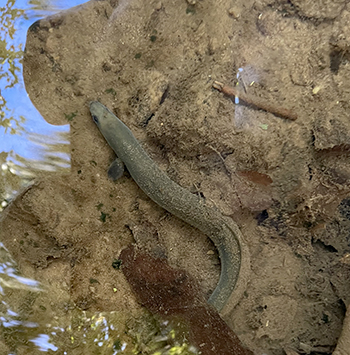Delaware • New Jersey • Pennsylvania
New York • United States of America
 |
| An American eel underwater. Photo by the DRBC. |
American eels, Anguilla rostrata, are a species of fish that are found in various freshwater and estuarine waterways in the Delaware River Basin, from rivers and creeks to lakes and ponds.
American eels are catadromous, which means they are born in the ocean, live as adults in freshwater and return to the ocean to reproduce. All eels reproduce/are born in the same place - the Sargasso Sea, which is a part of the Atlantic Ocean near the West Indies.
While a 2023 coastwide stock assessment of American eels by the Atlantic States Marine Fisheries Commission concluded that the stock is "depleted", local data from Delaware and New Jersey surveys suggest non-decreasing trends. The Delaware River is home to a relatively good eel population because there are no dams on its mainstem to prevent the eel's upriver migration.
Life Cycle
After hatching in the Sargasso Sea, American eel larvae travel on ocean currents to the U.S. eastern seaboard. These larvae are called glass eels because of their translucent bodies.
As they travel up estuaries and into rivers, they continue to grow and change color, from translucent to gray (called elvers) to yellow to silver. Maturity can take up to 20 years!
Once mature and the weather starts to turn colder, American eels will begin their journey down rivers and into the Atlantic Ocean, back to the Sargasso Sea.
Did You Know?
American eels are mostly nocturnal and live on the bottom of waterways, usually under rocks or in the mud. They can absorb oxygen through their skin, allowing them to be able to leave the water and travel through wet grass or mud. Adults eels are upwards of 5' (females) and 3' (males).
American eels play an important role in the life cycle of freshwater mussels. Mussel larvae will attach to the eel's gills; as the eels swim upstream, the mussel larvae are dispersed.
They are slimy to the touch due to a mucous layer in their skin, which is thought to ease friction while swimming and protect from pathogens that could enter through the skin.
American eels are an important predator and also are a vital food source to other animals. They are a good water quality indicator as they are long-lived and usually remain in the same habitat while reaching maturity.
In the upper Delaware River Basin, people still catch eels using old stone and wooden structures called eel weirs, which look like a backwards "V" in the water.
Links to Learn More
Copyright © Delaware River Basin Commission,
P.O. Box 7360, West Trenton, NJ 08628-0360
Phone (609)883-9500; Fax (609)883-9522
Thanks to NJ for hosting the DRBC website